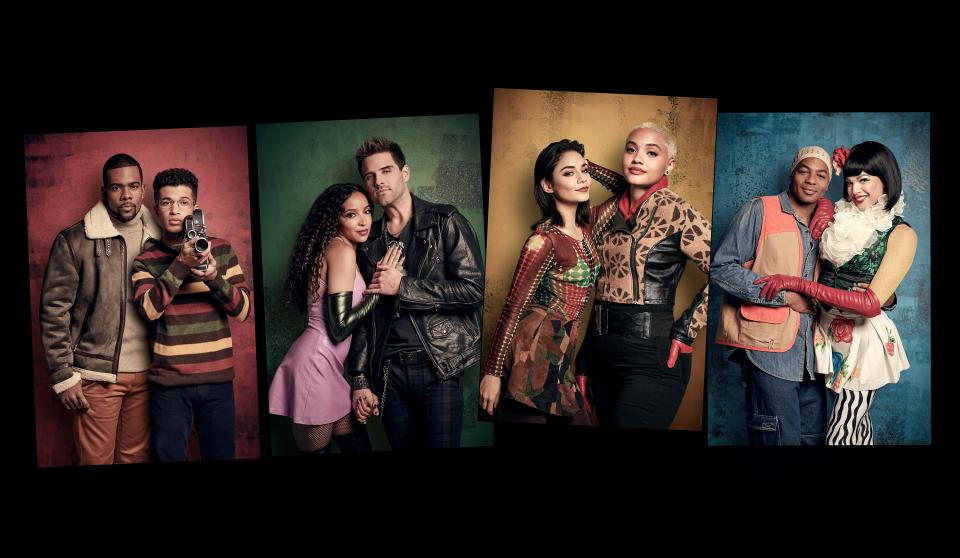Rent Live: How has the musical aged since 1996?
Fox’s live broadcast of Rent is up against the Screen Actors Guild Awards on Sunday, but the lineup actually makes a whole lot of sense — Rent has always given off a vibe of scrappy underdog.
When you look at Rent in context, it’s an important work: It deals frankly with the fallout of the AIDS crisis and its cast is almost unthinkably diverse by 1996 standards. Its enormous popularity contributed to the crisis’s prominence in pop culture and the national discourse, on the heels of works like 1993’s Philadelphia and Pedro Zamora’s season of The Real World.
But none of that means that Rent has stayed relevant, or even aged well. It’s telling that Larson kept the setting of Rent in the late ’80s, even as its revision process dragged it into the mid-’90s, and by extension, a different world. In Larson’s world, the Tompkins Square Park riot had just happened, but by 1996, the Village (and New York as a whole) was two years into Rudy Giuliani’s mayordom — which means that among other things, Times Square became rife with garish billboards and corporate stores, and police cracked down on homelessness throughout the city.
Rent as it stands now, is about as far removed from current NYC as it was from La Bohème in its own time.
There are other aspects to Rent that worth examining: For one thing, nearly all of the show’s LGBTQ characters seem to exist largely to suffer. And, for all of that much-touted diversity, the main characters are two straight white guys refusing to pay their black former roommate rent. (This casting has at least been addressed in Fox’s version.) How would that play as an elevator pitch to a network as anything than an obviously tone-deaf anti-comedy in 2019?
Roger and Mark’s refusal to pay rent — or even get a job — is either as radical as ever (in a “The system is broken, so why bother playing” kind of way) or just incredibly petulant. Given that, again, they’re two straight white guys, it seems to lean towards the latter. Benny successfully leveled-up in the world and for that, he deserves unending scorn and the murder of his dog? (Yeah, remember that?) Mark and Roger, by contrast, barely even seem to dedicate any work to their creative lives. As David Rakoff memorably put it on This American Life:
“Here’s what [Mark and Roger] do in Rent to show that they are creative. Nothing — they do nothing. They hang out. And hanging out can be marvelous. But hanging out does not make you an artist. A secondhand wardrobe does not make you an artist. Neither do a hair-trigger temper, melancholic nature, propensity for tears, hating your parents, nor even HIV — I hate to say it — none of these can make you an artist. The only thing that makes you an artist is making art. And that takes the opposite of hanging out.”
This s what really makes Rent seem even more dated: It’s exponentially harder to be a “creative” person professionally these days. Mark, who walks away from a full-time job to continue making his films — whatever those are — would, today, probably have a trust fund in his back pocket to make his principled moral decisions that much easier. (Who’s to say he didn’t back then, though?)
Another — much less weighty — issue is that the music landscape of 2019 is also completely unrecognizable from that of 1989. For Rent to aspire to a “new Hair,” that meant fusing rock music with show tunes. That was already going to be a tricky concept. Look at the critical “alt-rock” darlings of 1990, for what Larson would have to have been pulling to combine with Broadway music traditions : Depeche Mode, Violator; Pixies, Bossanova; Jane’s Addiction, Ritual de lo Habitual; Cocteau Twins, Heaven Or Las Vegas; Ride, Nowhere; Sonic Youth, Goo.
Excluding even some truly extreme outliers (Public Enemy’s Fear of a Black Planet and Megadeth’s Rust in Peace), that is a truly bananas list of influences to try and distill into a zeitgeist-capturing sound. And okay, sure, let’s ignore the critical darlings — let’s look at, say, the biggest four singles of the year:
Sinéad O’Connor, “Nothing Compares 2 U”
Madonna, “Vogue”
Vanilla Ice, “Ice Ice Baby”
MC Hammer, “U Can’t Touch This”

So we’ve got one case of poppy hip-hop, one case of appropriated hip-hop, one case of pop appropriated from the underground house music and LGBTQ scenes, and one case of whatever the hell you wanna say “Nothing Compares 2 U” is. (Also two cases of “you” spelled as “U,” which I blame on Prince.) The song in there that should have had the most impact on Rent‘s is “Vogue,” given where Madonna lifted it from, but you’d be hard-pressed to hear anything that sounds like the music that Rent‘s nominally diverse cast of characters would be listening to. Instead, you hear Larson, a straight white guy from the ‘burbs filtering his formative musical experiences through the Broadway musical tradition (and in particular, his obsession with Stephen Sondheim).
“My whole thing is that American popular music used to come from theatre and Tin Pan Alley, and there’s no reason why contemporary theatre can’t reflect real contemporary music,” Larson said in 1996, before responding to a question about his influences: “I loved Pete Townshend growing up, and I loved the old Police and Prince … I love Kurt Cobain and Liz Phair. Beatles.” That’s a pretty great list, albeit one that — with the exception of Phair and Cobain — does not reflect the time in which Rent was being created. Even if you’re being generous and assuming that Larson was gestating these influences as early as 1988, the Police had broken up two years prior, Pete Townshend and the Who’s most recent hits had happened in 1980 and 1982. (“Let My Love Open the Door,” and “Eminence Front,” respectively.) Even Prince’s inarguably best work was behind him by 1988. By the time Larson gave that interview, Kurt Cobain had been dead for nearly two years, and Liz Phair was almost three years removed from Exile in Guyville.
Of course, culture is moving a hell of lot more rapidly now, so it’s easy to point these things out with the invaluable benefit of hindsight. But the larger point is that, if Rent‘s music was an anachronism in 1996, it’s pre-ancient by 2019 standards, when someone searching for a truly modern, youth-oriented set of influences to combine with Stephen Sondheim would be pointed towards SoundCloud rap, Ariana Grande and, I don’t know, Greta Van Fleet? (Please, young composers: Do not take this as a challenge.)
Culture moves quickly, and you can’t fault something for being a product of its time. But Rent was already an anachronism when it appeared: Its lengthy gestation period meant that it probably never had a chance at lasting relevancy. How you measure a year in internet time? A year on Twitter? A year of selfies? It’s not easy. But then, neither is making rent.


